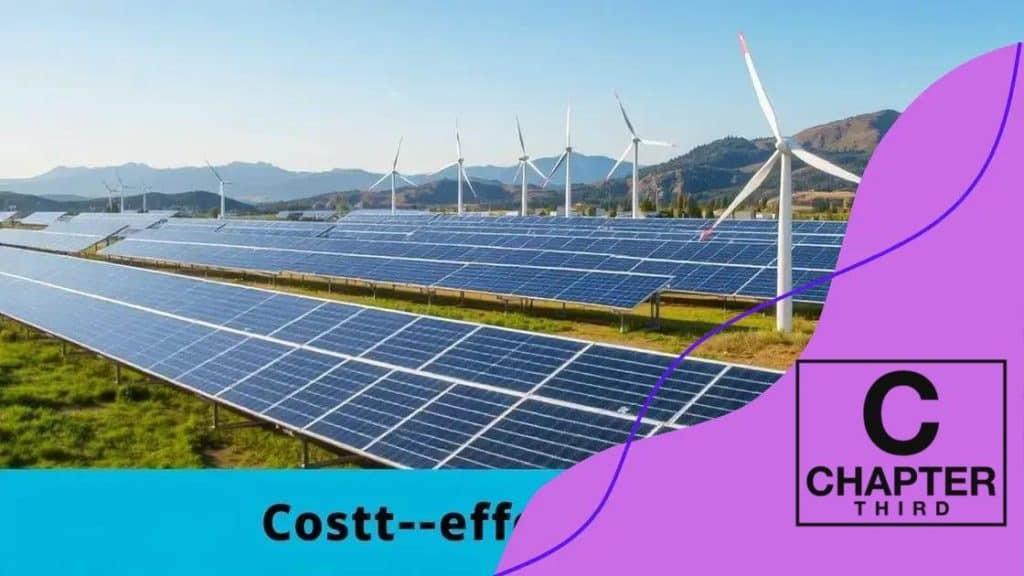Renewable energy now cheaper than coal: What it means for you

Renewable energy is now cheaper than coal, providing consumers with significant cost savings, reducing carbon emissions, and promoting a sustainable future through increased investment and technological advancements.
Renewable energy now cheaper than coal is a game changer for our planet and wallets. Have you ever wondered how this shift impacts your energy bills and the environment? Let’s dive into the details.
Understanding the shift in energy costs
The global landscape of energy is changing rapidly. Understanding the shift in energy costs is essential as renewable sources become more affordable than traditional fossil fuels. Have you noticed how solar and wind energy prices have dropped? This trend offers exciting opportunities for consumers and businesses alike.
Price Comparison
In recent years, the cost of generating electricity from renewable sources has fallen dramatically. According to various studies, renewables have become cheaper than coal in many regions. Here are some key factors influencing this shift:
- Technological advancements in solar and wind energy
- Government incentives promoting green energy
- The declining cost of production for renewable technologies
As more countries invest in renewable infrastructure, the energy market becomes more competitive. This is resulting in lower prices for consumers.
Impact on Consumers
What does this mean for you? As renewable energy options become cheaper, consumers can save money on their energy bills. Over time, homes equipped with solar panels are likely to see significant reductions in costs. Additionally, many utilities are starting to offer green energy plans at affordable rates.
The shift towards renewables also encourages better energy efficiency practices. Households and businesses are now more inclined to reduce energy consumption, as lower prices make it easier to implement energy-saving solutions.
Environmental Considerations
Beyond personal savings, understanding the shift in energy costs is crucial for environmental sustainability. Renewable energy sources have a lower environmental impact compared to coal. Resources like solar and wind produce clean energy, helping to reduce carbon emissions and combat climate change.
Following this trend, individuals and communities can contribute to a greener future. The broader adoption of renewables not only offers economic benefits but also aligns with global efforts to protect our planet.
Comparing renewable energy and coal prices
When comparing renewable energy and coal prices, the landscape has shifted dramatically in recent years. This change is crucial for consumers, industries, and the environment. Understanding the cost dynamics can help you make informed energy choices.
Current Pricing Trends
Renewable energy, particularly solar and wind, has seen significant reductions in cost. According to recent data, the cost of electricity from renewables is often lower than that from coal. Here are a few reasons driving the price drop:
- Increased efficiency in renewable technologies
- Mass production leading to cost reductions
- Declining installation costs
These factors contribute to making renewables more attractive as energy sources for consumers and businesses.
Cost Analysis
In direct comparison, coal remains a carbon-intensive option that carries additional environmental costs. While it has historically been cheaper, the external costs of coal production, such as health impacts and pollution, are significant. Transitioning to cleaner energy sources can reduce these hidden costs.
When weighing options, individuals and businesses should not only consider the upfront price of energy but also the long-term savings from choosing renewable energy. With many financial incentives available, including tax credits and rebates, the shift can become even more economical.
As the grid continues to evolve with a higher share of renewable sources, the pricing dynamics are likely to favor green energy even more. Investing in renewables is not just a choice for the environment; it’s increasingly becoming a financially sound decision.
Environmental benefits of cheaper renewables

The shift to renewable energy sources brings numerous environmental benefits, especially as they become cheaper. By choosing renewables, we not only save money but also contribute positively to the planet’s health.
Reduction in Carbon Emissions
One major advantage of cheaper renewables is the significant decrease in carbon emissions. Unlike coal and other fossil fuels, renewable energy sources like wind and solar produce little to no emissions during operation. This leads to cleaner air and a reduced impact on climate change.
- Improved air quality for communities
- Lower greenhouse gas emissions
- Mitigation of climate-related disasters
By transitioning to cheaper renewables, we can collectively make a difference in combating global warming.
Conservation of Natural Resources
Cheaper renewable energy also promotes the efficient use of natural resources. Renewables such as solar and wind harness energy that is abundant and inexhaustible. By shifting away from coal, we reduce the demand for mining and drilling, which can lead to habitat destruction and biodiversity loss.
Using renewable energy means we can conserve valuable natural resources, ensuring they are available for future generations. Additionally, this shift helps protect wildlife and ecosystems from the harmful impacts of fossil fuel extraction.
Improved Sustainability
As renewable technologies become more affordable, they pave the way towards a more sustainable future. Communities embracing renewables can enjoy energy independence, reducing reliance on imported fuels. This enhances energy security and stabilizes local economies.
Furthermore, the transition to cheaper renewables helps build resilient infrastructures, protecting us from the vulnerabilities associated with fossil fuel markets. Overall, this shift transforms how we produce and consume energy, aligning economic growth with environmental health.
How consumers can take advantage now
Consumers have a unique opportunity to benefit from the shift to renewable energy. Understanding how consumers can take advantage now is vital for those looking to save money and contribute to a sustainable future.
Exploring Renewable Energy Options
With the decline in costs, many households can now access renewable energy solutions. Installing solar panels has become more affordable, and many homeowners are opting for this green technology. This not only reduces reliance on traditional energy sources but also cuts monthly energy bills.
- Consider purchasing or leasing solar panels.
- Look for community solar programs in your area.
- Explore energy efficiency upgrades to complement solar energy.
By taking these steps, consumers can maximize savings while supporting clean energy initiatives.
Taking Advantage of Incentives
Various government incentives exist to help consumers switch to renewable energy sources. Tax credits, rebates, and grants are available in many regions to encourage the adoption of sustainable energy solutions. Utilizing these programs can significantly lower the costs of transitioning to renewables.
For example, federal tax credits can cover a percentage of installation costs for solar energy systems. Additionally, some local governments offer financial incentives for energy-efficient upgrades. Being informed about these resources empowers consumers to make decisions that benefit both their wallets and the planet.
Participating in Energy Programs
Another way consumers can take advantage of the renewable energy shift is by participating in energy programs. Many utilities now offer options for consumers to choose green energy plans. These plans typically allow customers to purchase energy derived from renewable sources at competitive rates.
In addition, demand response programs incentivize energy-saving behaviors during peak times. Enrolling in such programs not only provides potential savings but also supports the larger goal of reducing energy consumption and reliance on fossil fuels.
By making informed choices and participating in available programs, consumers can align their energy usage with their values. This collective action plays a significant role in accelerating the transition toward a cleaner, more sustainable energy future.
Future outlook for renewable energy investments
The future outlook for renewable energy investments is bright and promising. As countries strive to meet climate goals, there is an increasing focus on investing in sustainable energy solutions. This shift represents not only a commitment to the environment but also a robust economic opportunity for businesses and individuals.
Growing Market Demand
Investments in renewable energy are expected to continue growing. As technology advances, more people are recognizing the financial benefits of renewable sources like wind, solar, and hydroelectric power. Companies that invest in these technologies are likely to see a positive return as demand for clean energy rises.
- Increased adoption of electric vehicles.
- Growing consumer demand for sustainable products.
- Enhanced energy storage solutions and technology.
This surge in market demand creates a domino effect, encouraging further investment and innovation in the sector.
Government Policies and Incentives
Government policies play a critical role in the future of renewable energy investments. Many countries are implementing favorable regulations, incentives, and subsidies to accelerate the shift towards green energy. These supportive policies help reduce risks for investors and make renewable energy projects more attractive.
Public funding, tax benefits, and grants encourage both private and public entities to invest in renewable energy infrastructure. As these policies evolve, they provide a strong foundation for long-term growth in the renewable sector.
Technological Innovations
Continued advancements in technology are another key factor driving the future of renewable energy investments. Innovations in solar panel efficiency, wind turbine design, and battery storage solutions enhance the viability and attractiveness of renewable projects. As technologies improve, costs decrease, making investments more appealing.
Moreover, the development of smart grid technologies enables better management of energy resources, maximizing efficiency. The rise of decentralized energy solutions also empowers communities, leading to broader participation in the energy market.
Investing in renewables is increasingly viewed as essential not only for sustainability but also for economic growth. With the alignment of market demand, supportive policies, and innovative technologies, the future of renewable energy investments looks tremendous.
FAQ – Frequently Asked Questions about Renewable Energy Investments
What are the benefits of switching to renewable energy?
Switching to renewable energy can reduce energy bills, lower carbon emissions, and contribute to a healthier environment.
How can consumers take advantage of government incentives for renewables?
Consumers can explore tax credits, rebates, and grants that make it more affordable to install renewable energy systems like solar panels.
What impact does investing in renewables have on the economy?
Investing in renewable energy can lead to job creation, innovation, and economic growth in the clean energy sector.
How do technological advancements affect renewable energy investments?
Technological advancements improve efficiency and reduce costs, making renewable energy options more accessible and attractive to consumers and investors.





